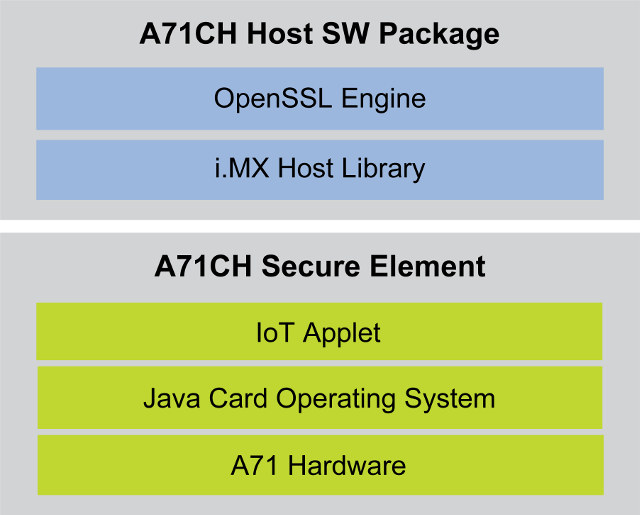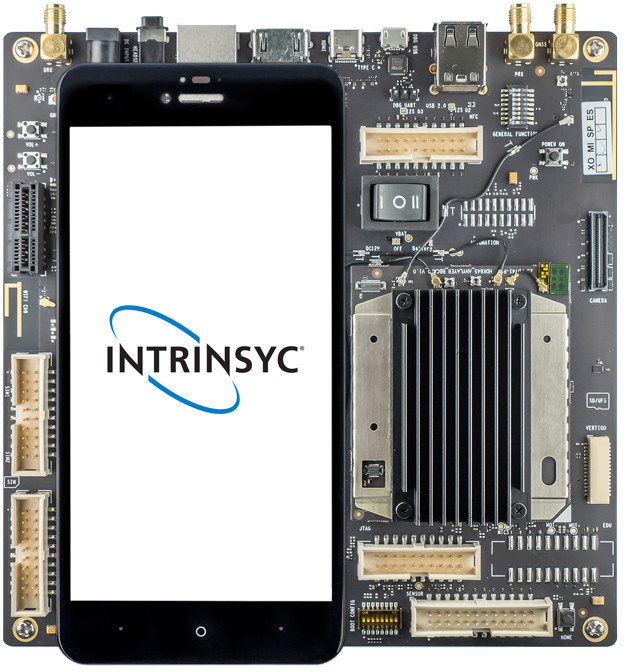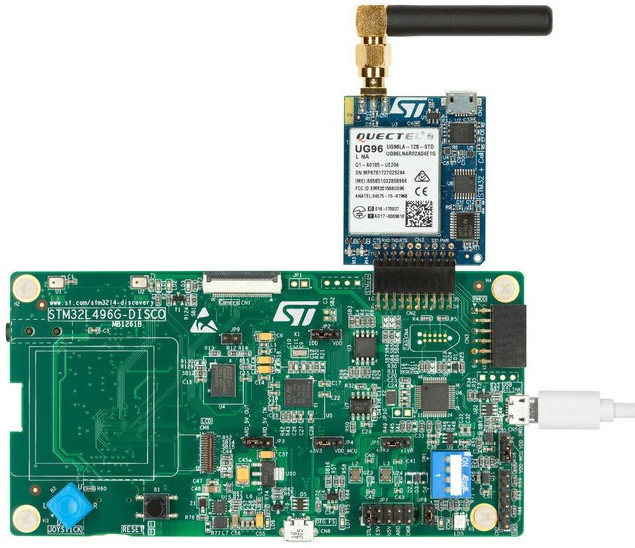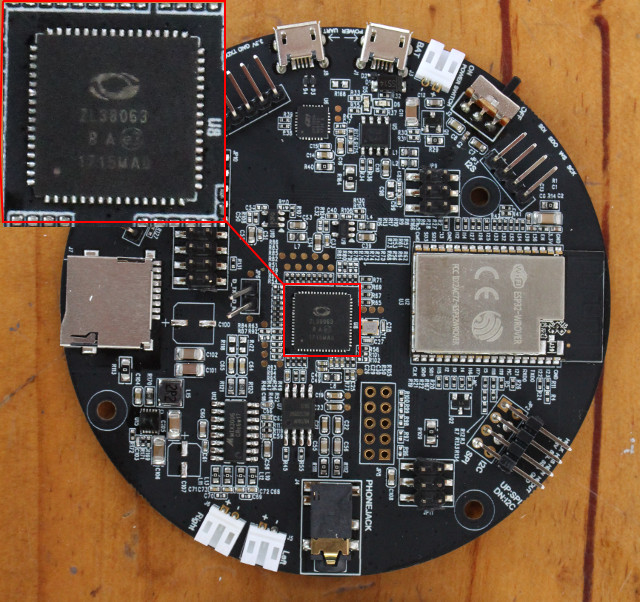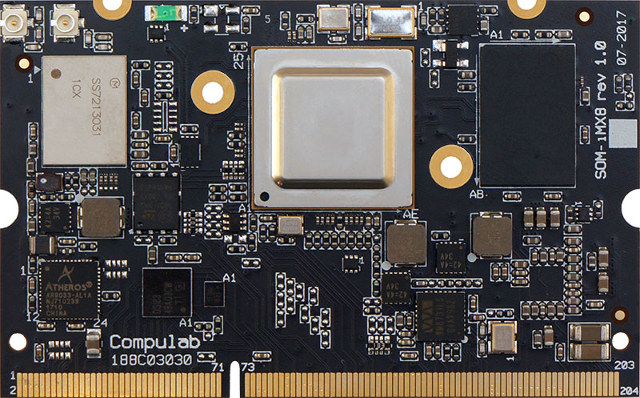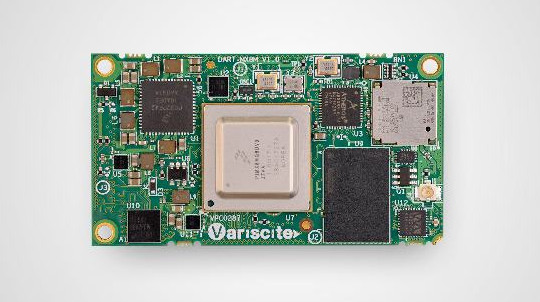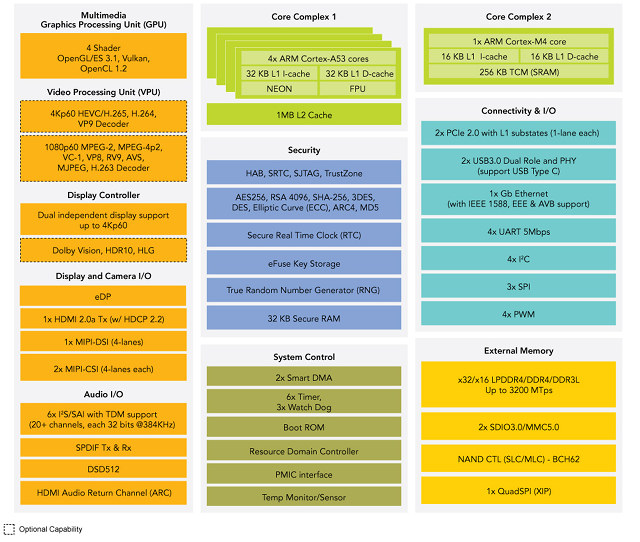The industry clearly has an issue at hand with the security of the Internet of Things, and the problem is complex as some devices are easily accessible due to bad configuration (e.g. default username/password), while others may have security flaws at various levels of the software stack from the low level bootloaders to the operating systems, and applications. Nowadays, devices also need to be upgradeable, and communicate with the cloud, and that introduces other attack vectors in case malignant firmware is installed instead, or a man-in-the-middle attack occurs. While some people may claim security can be achieved by software only, we are seeing security evolving towards combined software and hardware solutions, for example with Arm Trustzone built into SoCs, but some companies are also introducing Secure Element chip, which Samsung has already done and integrated into their Artik modules to secure data from the hardware to the cloud. NXP has […]
Intrinsyc Open-Q 845 HDK Development Kit for Snapdragon 845 Processor Available for $1079
Qualcomm Snapdragon 845 based devices such as Samsung Galaxy S9/S9+ smartphones and Windows 10 Always-Connected Mobile PCs should start shipping in the next few weeks, and as usual with every new premium Qualcomm Snapdragon Mobile Platform, we get an Open-Q development from Intrynsyc. Intrinsyc Open-Q 845 HDK is also equipped with 6GB LPDDR4x RAM, 128GB UFS2.1 Flash, a wireless module with 802.11ac/ad WiFi and Bluetooth 5.0, Gigabit Ethernet, USB interfaces, HDMI and DisplayPort video output, up to 3 cameras, and plenty more. Intrinsyc Open-Q 845 HDK specifications: SoC – Qualcomm Snapdragon SDA845 Octa-core 64-bit processor with 4x high-performance Kryo 385 cores up to 2.80 GHz, 4x low-power Kryo 385 cores up to 1.8 GHz, Qualcomm Adreno 630 GPU with support for OpenGL ES 3.2, OpenCL 2.0 Full, Vulkan, DX12, and Qualcomm Hexagon 685 DSP System Memory – 6GB LPDDR4x RAM Storage – 128GB UFS2.1 Flash, micro SD 3.0 UHS-1 slot […]
A First Look at ESP32-LyraTD-MSC Audio Mic HDK with Baidu DuerOS Assistant
Earlier this year, Espressif Systems had unveiled their ESP32-LyraTD-MSC Audio MiC HDK (Hardware Development Kit) which features an ESP32-WROOM module, a 4-mic array DSP, 3 microphones, an audio jack, and various I/Os. I received the board a couple of weeks ago, and while there’s no public information released yet, the company provided me with ESP32-LyraTD-MSC User Guide in English. Eventually, I’d expect Google Assistant and Amazon Alexa to be supported, but in the meantime I had to leverage my (lowly) Chinese language skills to get started since the kit is pre-loaded with firmware connecting to Baidu DuerOS voice assistant. ESP32-LyraTD-MSC Unboxing The kit came in a bland Espressif Systems carton box. Inside the package, I could only find one kit comprised of two boards. The bottom board read ESP32_MicrosemiDSP_Mainboard-V1, and does not show much apart from marking for connectors, headers and the power switch. While the top comes with eight […]
STMicro Introduces Two STM32 Discovery Kits with 2G/3G or 4G LTE-IoT Cat M1/NB1 Connectivity
Embedded World 2018 trade fair will take place on on take place on February 27 – March 1 in Nuremberg, Germany, and we’re starting to see some company announce new products and solutions for the embedded market. STMicro has just announced their showcase their very first cellular development kits at the event, based on a display-less variant on their 32L496GDISCOVERY Discovery board with cellular add-on boards: P-L496G-CELL01 Discovery kit with with a 2G/3G modem P-L496G-CELL02 Discovery kit with with an LTE-IoT Cat M1 (eMTC) / NB1 (NB-IoT) / 2G model Now the company has not started designed their own cellular modem, but instead relying on QUECTEL modems. Both kits share most of the same specifications: MCU – STMicro STM32L496AGI6 Arm Cortex M4F MCU@ 80 MHz with 1 MB Flash, 320 KB RAM in a UFBGA169 package On-board memory – 8 Mbit PSRAM On-board + external storage – 32 KB I2 […]
MicroSemi ZL38063 Audio Processor is Designed for Microphone Arrays
I’ve already been experimenting with DIY smart speakers and corresponding services for example using ReSpeaker board with Microsoft Bing Speech API, or Orange Pi Zero with Google Assistant SDK. But so far all the hardware platforms I used only came with one microphone, no microphone array that help with wake word detection in noisy environments. Last week-end, I received Espressif Audio Mic HDK, an ESP32 board with a 3-microphone array which I’ll review a in a few weeks once documentation becomes available and I clear some other items in my review list. In the meantime, I checked out the hardware, and found out the mainboard also comes with Microsemi ZL38063 audio processor specifically designed for microphone array. The chip was released las year, and can be already found in the company’s AcuEdge Development Kit for Amazon AVS, but since I’m going to use a board based on ZL38063 I’d thought […]
Compulab CL-SOM-iMX8 SoM Features NXP i.MX 8M Processor for $68 and Up
I just covered one of the i.MX 8M systems-on-module last Friday with Variscite DART-MX8M SoM, but Variscite is not the only company about to launch such modules, and today I’ll have a look at Compulab CL-SOM-iMX8 system-on-module based on the same NXP i.MX 8M dual or quad core Cortex A53 processor. Compulab’s SoM comes with up to 4GB RAM, 64GB eMMC flash, an optional WiFi & Bluetooth module, as well as optional support for Ethernet, LVDS, analog audio, and more. Contrary to most competitors, the company has also made an habit of releasing detailed pricing the basic configuration and per option. But first, let’s go through the specifications: SoC (one of the other) NXP i.MX8M Quad quad core Arm Cortex-A53 processor @ 1.5GHz with Arm Corex-M4 real-time core, Vivante GC7000Lite GPU supporting OpenGL ES 3.1, Open CL 1.2 and Vulkan NXP i.MX8M Dual dual core Arm Cortex-A53 processor @ 1.5GHz […]
Variscite DART-MX8M is a Compact NXP i.MX 8M System-on-Module
NXP has recently launched their i.MX 8M evaluation kit and released documentation, so we can expect multiple products based on the family in 2018. The new NXP i.MX 64-bit processors include three families with i.MX 8, i.MX 8X, and i.MX 8M, but so far it looks like many companies are launching products based on the latter. The Embedded World Conference 2018 at the end of February should be the occasion for many product launches, especially systems-on-module and related development kit, but several companies have already posted information about their i.MX 8(M) modules minus pricing, and one of those is Variscite DART MX8M a company (55x30mm) module with i.MX 8M processor, up to 4GB LPDDR4, up to 64GB eMMC flash, as well as 802.11ac WiFi and Bluetooth 4.0. Variscite DART-MX8M specifications: SoC – NXP i.MX8M with dual or quad core Cortex A53 processor @ up to 1.5 GHz, Cortex-M4 real-time core […]
Develop NXP i.MX 8M Voice Controlled Smart Devices with MCIMX8M-EVK Evaluation Kit
We first heard about NXP i.MX 8M processsors in October 2016, and at the end of last year, WandPi 8M development board was unveiled with shipping scheduled for Q2 2018 once the processor will start manufacturing. Other exciting i.MX 8M projects include Purism Librem 5 smartphone, MNT Reform DIY modular computer, and I’m sure there will be others development board & products, and plenty of system-on-modules introduced with the processor in 2018. NXP i.MX 8M processor also got in the news at CES 2018, because it will be one of the hardware platforms certified for Android Things, and NXP also issued a press release to announced the processor’s multimedia capability with be used in voice controlled devices with or without video. The PR refers to Gartner Research saying that “voice commands will dominate 50 percent of all searches in the next two years”, and explains that with thinner and thinner […]


